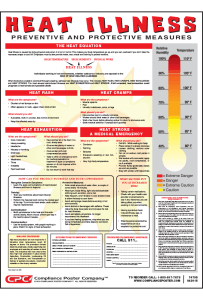 According to the Occupational Safety and Health Administration (OSHA), every year, dozens of workers die and thousands more become sick while working in extreme heat conditions. With summer only a few weeks away, employers must start preparing to reduce the risk of heat-related injuries to their workers. Under Federal OSHA law, employers are responsible for providing workplaces free of known safety hazards, including protecting employees from extreme heat.
According to the Occupational Safety and Health Administration (OSHA), every year, dozens of workers die and thousands more become sick while working in extreme heat conditions. With summer only a few weeks away, employers must start preparing to reduce the risk of heat-related injuries to their workers. Under Federal OSHA law, employers are responsible for providing workplaces free of known safety hazards, including protecting employees from extreme heat.
Prevention
Employers should implement a plan to prevent heat-related illnesses. Employers can:
- Provide workers with water, rest, and shade;
- Train workers to recognize symptoms in themselves and others;
- Allow new or returning workers to acclimatize by gradually increasing their workloads or allowing more frequent breaks;
- Reduce the physical demands of the job. If heavy job tasks cannot be avoided, change work/rest cycles to increase the amount of rest time;
- Monitor workers for signs and symptoms; and
- Implement an emergency response procedure.
Symptoms
To take appropriate measures, it is important to recognize the symptoms of excessive heat exposure. These are illnesses that may result from heat exposure in the workplace:
- Heat stroke is the most serious heat-related illness. It happens when the body becomes unable to regulate its core temperature. Symptoms include confusion, loss of consciousness, and seizures.
- Heat exhaustion is the body’s response to loss of water and salt from heavy sweating. Symptoms include headache, nausea, dizziness, weakness, irritability, thirst, and heavy sweating.
- Heat cramps happens when the body losses salts and fluid during sweating. Low salt-levels in muscles cause painful cramps. Cramps may occur during or after working hours.
- Heat rash is the most common heat-related illness. It is skin irritation caused by sweat that does not evaporate from the skin.
Training Tools
CPC offers the following products that can be used for your training programs.
Outdoor Heat Stress Illness Prevention Poster

